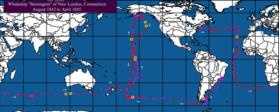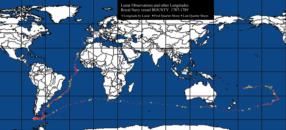
38Talk:
A Forum for Discussions among Voyagers and Others related to the 38th Voyage of the Charles W. Morgan
From: UNK
Date: 2014 Jul 9, 13:52 -0400
(regular book) http://www.amazon.com/Longitude-Genius-Greatest-Scientific-Problem/dp/080271529X/ref=pd_cp_b_0
(with more photos and illustrations) http://www.amazon.com/Illustrated-Longitude-Greatest-Scientific-Problem/dp/B00450V1G8/ref=sr_1_1?s=books&ie=UTF8&qid=1404928202&sr=1-1&keywords=the+illustrated+longitude
A few days ago, John Bryant, you asked:
"what do you mean by "shoot lunars"? "Lunars were a method for determining longitude. The Moon's position relative to the Sun or other stars functions like the hand of a great clock in the sky. A navigator would hold a sextant more or less "sideways" and measure the angle between the limb of the Moon and the limb of the Sun. As the Moon travels around the sky, the angle from the Sun increases from near 0° at New Moon to near 180° at Full Moon and then back to zero again at the following New Moon. The rate of change is just about 13° per day so if we can carefully and accurately measure the angle between the Moon and the Sun (or a group of selected stars), then we can measure absolute time (today we refer to this absolute time as "UT" or Universal Time though modern navigators still habitually refer to it as GMT or Greenwich Mean Time). By comparing absolute time with local or "sundial" time, we can get our longitude --how far away we are from the Prime Meridian. Every hour difference between GMT and local time is equal to 15° difference in longitude. In short, when shooting "lunars", the Moon becomes our chronometer.
Lunars were quite popular aboard American vessels (frugal Yankees preferred them over expensive chronometers), and they were an enabling technology for New England whaleships like the Morgan. I like to characterize whaling as an almost "Stone Age" activity --groups of men with pointy sticks killing enormous animals at great peril-- but when the Morgan was sailing, these were "hunters with logarithms". They employed some of the greatest discoveries of lat 18th century mathematics and astronomy to sail the globe. Aboard the Morgan, lunars were used on at least the first voyage and probably on a couple of later voyages, but I should add that lunars were already in decline in the 1840s and nearly vanished after 1850 as chronometers became more common and less expensive.
Lunars have had a somewhat infamous reputation as exceedingly difficult sights with long mathematical calculations --the sort of thing that only a real mathematician could enjoy and certainly not an average mariner. But that's legend. The mathematical work of "clearing" a lunar was not substantially different from the work for a common "time sight" (for local time) which every practicing navigator learned in the 19th century.
I've previously posted a map of the first voyage of the Charles W. Morgan showing the locations on that voyage where they used lunars for longitude. I'm including another map that I created (below) showing the voyage of the whaleship Stonington of New London, also highlighting lunars (yellow squares). As I say, lunars were declining rapidly in the 1840s, and you can see that the captain of the Stonington only checked his longitude with lunars occasionally. For a more interesting example, I'm also including my map of the voyage of the Bounty from 1787 until the mutiny in the western Pacific in 1789. William Bligh was a skillful navigator, and you can see that he used lunars frequently on that voyage as a check on the early chronometer that he also had on board.
Lunars are popular again today among navigation enthusiasts because they demand more attention in adjusting and using a sextant, and they're the best way to assess a sextant's accuracy. It's also interesting to note that Jim Lovell shot lots of lunars aboard Apollo 8 in 1968 on the first space flight to the Moon. Of course, by then, there was no doubt about GMT. Shooting lunars in the Apollo era was a means of double-checking the spacecraft's trajectory. Myself, I've been working on (and promoting) a method of fixing a vessel's position at sea using visual observations of artificial satellites which is very similar to that "Space Age" use of lunars.
Joshua Slocum, during his circumnavigation, famously shot a lunar in 1897, decades after they had become obsolete. Lunars have a certain charm since they allow a navigator to determine a vessel's position entirely by astronomical mean, with no "blackbox" chronometer in the mix. And Slocum in 'Sailing Alone Around the World' wrote a nice epitaph for lunars as historically practiced: "The work of the lunarian, though seldom practised in these days of chronometers, is beautifully edifying, and there is nothing in the realm of navigation that lifts one’s heart up more in adoration."
Frank Reed
ReedNavigation.com
Conanicut Island USA
Attached File:
(025-stonington-lunars.png: Open and save)
Attached File:
(011-bounty-lunars-chart.png: Open and save)
--










